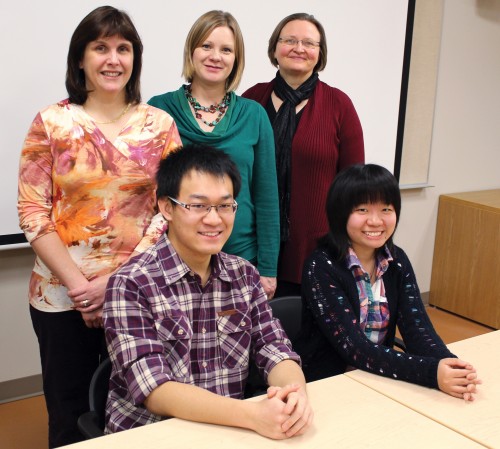Cross-cultural conversations
The U of S is opening its doors to more international students than ever before, but making sure those students have the English skills to succeed in and out of class and on and off campus is no small task.
By Kris Foster "When I came to the U of S, I visited all sorts of centres across campus," said Marie Lovrod, co-ordinator of the Women's and Gender Studies program. "There were programs that helped students acquire English for academic purposes, but there were few opportunities for international students to interact with domestic students, basically as a learning resource. Most of these students learn English in the Language Centre and are often in numeracy fields and that means cross-cultural conversations don't happen a lot."
"When I came to the U of S, I visited all sorts of centres across campus," said Marie Lovrod, co-ordinator of the Women's and Gender Studies program. "There were programs that helped students acquire English for academic purposes, but there were few opportunities for international students to interact with domestic students, basically as a learning resource. Most of these students learn English in the Language Centre and are often in numeracy fields and that means cross-cultural conversations don't happen a lot."
So Lovrod, who arrived in Saskatoon in 2006 from New York where interactions with people from all corners of the world are quite common in educational environments, began looking for ways to get international students from the Language Centre into her women and gender studies classes so they could learn through conversations with English-speaking students. The semester systems of the university and Language Centre are different, but with the help of the Language Centre, Lovrod was able to find a fourto- five week overlap when she could bring international and domestic students together in a seminar class on feminist qualitative research.
"Both groups had something to learn from each other," said Lovrod, who eased the international students into her class with the help of Lisa Krol, Kara Loy and other Language Centre staff. "The international students who participated in the seminar classes got to practice English and the women and gender studies students got to learn that in qualitative research, you can't make assumptions about world views."
The class also included a chance for the students to take part in "everyday interactions, like going to a movie or the art gallery. There are powerful lessons for both groups and they had brilliant observations."
The experience from the trial class led to more support from "the two Davids," Lovrod explained, referring to David Parkinson, director of the Learning Centre, and David J. Parkinson, vice-dean of humanities and fine arts in the College of Arts and Science. "We were able to launch the ‘Bridging Course Pilot Project', which allowed international students to enroll in a women and gender studies class and be intentionally grouped with a couple students over an ongoing period of time."
The pilot class is now over and graduate student Sara York, who participated in one of the original classes Lovrod initiated, is preparing a report on the outcomes by interviewing students and arranging focus groups.
"The report will be done this term, but we have already seen positive results like improved listening scores and reading comprehension scores. It is useful to take part in discussions with people with different perspectives and who lived under different policies. It was transformative for the students and the instructors."
What Lovrod and her colleagues from the Language Centre know for certain is that "this method can be applied to other subjects and we want to explore the possibility to make these opportunities available to more students."
They also hope to share what they learn with those beyond the university community. "Immigration laws in Saskatchewan are changing. For example, there are more international students in public schools making this transition and acquiring English skills. We would like to have conversations (with school divisions) and share what we learn."
It has taken a lot of time and many hands to get this project to where it is, said Lovrod, but "it is an important social vision. There is a deeper and more powerful opportunity when we think across cultures to learn from one another."

